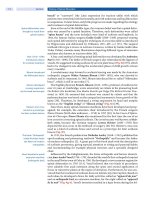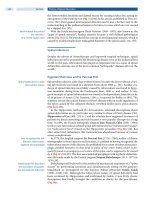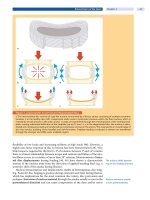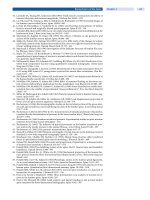Spinal Disorders: Fundamentals of Diagnosis and Treatment Part 23 docx
Bạn đang xem bản rút gọn của tài liệu. Xem và tải ngay bản đầy đủ của tài liệu tại đây (531.4 KB, 10 trang )
77. StaerkleR,MannionAF,ElferingA,JungeA,SemmerNK,JacobshagenN,GrobD,Dvorak
J, Boos N (2004) Longitudinal validation of the fear-avoidance beliefs questionnaire (FABQ)
in a Swiss-German sample of low back pain patients. Eur Spine J 13 4:332–340
78. Stärkle R, Mannion AF, Junge A, Elfering A, Grob D, Dvorak J, Boos N (2002) The influence
of baseline psychological factors on outcome after spine surgery. SIROT. San Diego, USA
79. Stromqvist B (2002) Evidence-based lumbar spine surgery. The role of national registration.
Acta Orthop Scand Suppl 73 305:34–39
80. Stromqvist B, Fritzell P, Hagg O, Jonsson B (2005) One-year report from the Swedish
National Spine Register. Swedish Society of Spinal Surgeons. Acta Orthop Suppl 76 319:1–24
81. Stromqvist B, Jonsson B, Fritzell P, Hagg O, Larsson BE, Lind B (2001) The Swedish National
Registerforlumbarspinesurgery:SwedishSocietyforSpinalSurgery.ActaOrthopScand
72 2:99–106
82. Sun EC, Wang JC, Endow K, Delamarter RB (2004) Adjacent two-level lumbar discectomy:
outcome and SF-36 functional assessment. Spine 29 2:E22–27
83. Tandon V, Campbell F, Ross ER (1999) Posterior lumbar interbody fusion. Association
between disability and psychological disturbance in noncompensation patients. Spine 24
17:1833–1838
84. Trief PM, Grant W, Fredrickson B (2000) A prospective study of psychological predictors of
lumbar surgery outcome. Spine 25 20:2616–2621
85. Uomoto JM, Turner JA, Herron LD (1988) Use of the MMPI and MCMI in predicting out-
come of lumbar laminectomy. J Clin Psychol 44 2:191–197
86. Vaccaro AR, Ring D, Scuderi G, Cohen DS, Garfin SR (1997) Predictors of outcome in
patients with chronic back pain and low-grade spondylolisthesis. Spine 22 17:2030–2034;
discussion 2035
87. Van Susante J, Van de Schaaf D, Pavlov P (1998) Psychological distress deteriorates the sub-
jective outcome of lumbosacral fusion. A prospective study.Acta Orthop Belg 64 4:371–377
88. Waddell G, Morris EW, Di Paola MP, Bircher M, Finlayson D (1986) A concept of illness
tested as an improved basis for surgical decisions in low-back disorders. Spine 11 7:712–719
89. Wetzel FT, McCracken L, Robbins RA, Lahey DM, Carnegie M, Phillips FM (2001) Temporal
stability of the Minnesota Multiphasic Personality Inventory (MMPI) in patients undergo-
ing lumbar fusion: a poor predictor of surgical outcome. Am J Orthop 30 6:469–474
90. Woertgen C, Rothoerl RD, Breme K, Altmeppen J, Holzschuh M, Brawanski A (1999) Vari-
ability of outcome after lumbar disc surgery. Spine 24 8:807–811
91. Young JN, Shaffrey CI, Laws ER, Jr., Lovell LR (1997) Lumbar disc surgery in a fixed com-
pensationpopulation:amodelforinfluenceofsecondarygainonsurgicaloutcome.Surg
Neurol 48 6:552–558; discussion 558– 559
92. Zanoli G, Stromqvist B, Padua R, Romanini E (2000) Lessons learned searching for a HRQoL
instrument to assess the results of treatment in persons with lumbar disorders. Spine 25
24:3178–3185
Predictors of Surgical Outcome Chapter 7 197
8
History and Physical Examination
Cl´ement M.L. Werner, Norbert Boos
Core Messages
✔
Back pain is one of the most common causes
for a medical consultation
✔
Up to 85% of individuals will experience back
pain at least once in their lifetime
✔
The high rate of benign back/neck pain
increases the risk of overlooking serious spinal
disorders
✔
Findings (red flags) suggesting serious pathol-
ogy are: features of cauda equina syndrome,
severe night pain, significant trauma, fever,
unexplained weight loss, history of cancer,
patient over 50 years of age, and use of intrave-
nous drugs or steroids
✔
Back pain getting worse during the night may
indicate a tumor or infection
✔
Tumors, discitis/spondylodiscitis, acute frac-
tures, relevant pareses, or conus/cauda equina
syndromes need immediate further diagnostic
work-up in a specialized spine unit
✔
Spinal disorders can be classified as specific
(with morphological correlates) vs. non-specific
(without structural findings)
✔
Central (axial) pain should be differentiated
from peripheral (radicular) pain
✔
The physical examination is facilitated when a
certain sequence of different examining posi-
tions are used, i.e. walking, standing, sitting,
lying supine, lying on the left/right side, lying
prone
✔
The most important aspects of the clinical
examination are the spinal balance and the
neurological assessment
✔
The sagittal profile (lordosis/kyphosis) varies to
a large extent
✔
In the flexed neck position, rotation of the
upper cervical spine and in the extended posi-
tion rotation of the lower cervical spine is
assessed
✔
The Las `egue test is positive if radicular leg pain
is provoked during lifting of the ipsilateral leg
✔
Abnormal illness behavior should caution one
to consider a spinal intervention
✔
The reproducibility of the patient’s history and
examination is limited
Epidemiology
Generally, spinal pain
is common, benign,
and self-limiting
Back and neck pain are a very common medical problem and a predominant
cause for visits and medical consultations [15]. The reported lifetime prevalence
of back pain ranges up to 84% [5] and that of neck pain to 67% [6]. Dorsal (tho-
racic) pain is much less frequent. The 1-year prevalence of dorsal pain was 17%
compared to 64% for neck and 67% for low-back pain in a Finnish study [25].
More than 90% of patients initially presenting with back pain can be managed
non-operatively with physical therapy and analgetic medication and will return
to an acceptable pain level within 3 weeks, and even to normal within 3 months
[10]. These figures indicate that spinal pain is a benign and self-limiting disorder
(see Chapter
6 ).
About 85% of patients can be classified as having non-specific back pain (see
Chapter
21 ), i.e. no morphological correlate can be detected which would satis-
factorily explain the pain [10, 30]. The diagnostic challenge in patients with spi-
nal disorders is a result of the very high rate of benign spinal pain which poses a
Patient Assessment Section 201
ab
c
d
Case Introduction
A 46-year-old male was referred for an imaging study of the lumbar spine and possible surgical treatment of an acute
foot drop. The clinical history revealed a sudden onset (about 6 h), paresis of the left foot (long extensors of the greater
toe and foot) with relevant muscle weakness (M1–2). However, the patient did not report any significant back pain and
only mild pain in the lower limb. An MRI investigation was prompted because of the sudden onset of the paresis.
a The
sagittal T2 W image showed a minor disc protrusion (arrowhead) with contact to the nerve root L5 (arrow).
b In the axial
view, only a small foraminal disc protrusion is seen without clear neural compromise. The MRI could not satisfactorily
explain the severe foot drop and the patient was reassessed clinically.
c The patient was unable to extend his left foot
while sitting on the examination table.
d However, he was able to lift his left leg in a right sided position indicating nor-
mal muscle force for the hip abductors (L5). This discrepancy was indicative of a peripheral paresis of the peroneal mus-
cles which was later documented by neurophysiology. Completion of the patient’s history revealed that he was kneeling
for several hours repairing a floor in his house the day before the onset of the foot drop.
Rule out specific causes
of spinal pain
great risk of overlooking a serious pathology. Therefore, the most important
aspect of the diagnostic work-up is to rule out:
relevant paresis (<MRC Grade 3)
bowel and bladder dysfunction
tumor/metastasis
infection
inflammatory diseases
occult (osteoporotic) fractures
A thorough and standardized clinical assessment allows for an effective triage
and further diagnostic work-up of patients with suspected specific causes of back
pain.
202 Section Patient Assessment
History
History contributes most
to a clinical diagnosis
Due to the broad range of clinical entities that may present with back, dorsal and
neck pain, a systematic and logical approach, a skillful interpretation, and a care-
ful analysis of history data should be performed prior to the physical examina-
tion [8, 9]. In many cases a highly probable diagnosis can be made from the
patient’s history alone. Back and neck pain has a strong tendency to become
chronic (see Chapter
6 ). Therefore, a rapid, pathomorphology-oriented diag-
nostic work-up and initiation of treatment is mandatory.
The major goal of the clinical assessment is to differentiate:
specific spinal disorders, i.e. with a pathomorphological correlate
non-specific spinal disorders, i.e. without an evident pathomorphological
correlate
The diagnosis of
non-specific neck/back pain
is made by exclusion
In specific spinal disorders a pathomorphological (structural) correlate can be
found which is consistent with the clinical presentation. Accordingly, in non-spe-
cific spinal disorders no such correlate can be detected. It is obvious that patients
are classified in the latter group by exclusion. Unfortunately, the sources of
patients’ complaints remain unclear in the vast majority of cases (85–90%)
despite a thorough clinical and diagnostic work-up [30]. However, in the individ-
ual case it can be difficult to differentiate specific and non-specific disorders and
afinalconclusionisonlyreachedafterathoroughfurtherdiagnosticwork-up.
The most devastating failure of the clinical assessment is to overlook the pres-
ence of a tumor, infection, or a spinal compression syndrome. This can be
avoided in most cases, if the examiner considers possible specific causes during
history taking and physical examination. If suspicion is raised, the proper diag-
nostic work-up is prompted. The importance of this triage has led to the sugges-
tion of a so-called flag system (see Chapter
6 ). The red flags are of particular
relevance because they help to detect serious spinal disorders [1]:
features of cauda equina syndrome
severe and worsening pain (especially at night or when lying down)
significant trauma
fever
unexplained weight loss
history of cancer
patient over 50 years of age
use of intravenous drugs or steroids
Features of cauda equina syndrome include urinary retention, fecal inconti-
nence, widespread neurological symptoms and signs in the lower limb, including
gait abnormality, saddle area numbness and a lax anal sphincter [1]. A relevant
paresis can be defined as the inability of the patient to move the extremity against
gravity. It is particularly important to recognize a progressive weakness because
emergency exploration and treatment is necessary. It is always astonishing that
patients do not spontaneously report a disturbance of their bowel and bladder
function because they do not suspect a correlation with a spinal problem. Other
color (i.e. yellow, blue, black) flags indicate obstacles to recovery from an acute
episode (Chapters
6 , 21 ).
After red flags are explored, the clinical assessment focuses on the three major
complaints which lead the patients to seek medical advice:
pain
functional impairment
spinal deformity
Of these three complaints, pain is by far the most common aspect.
History and Physical Examination Chapter 8 203
Pain
Although pain is the most common complaint in patients with spinal disorders,
our understanding of the pathophysiology of pain is still scarce. However, molec-
ular biology has recently unraveled some basic mechanisms of pain generation
and persistence which help to better understand patients presenting with spinal
pain (Chapter
5 is strongly recommended for further reading).
Differentiation of Pain
The most obvious differentiation of spinal pain syndromes is based on the region
of the pain, i.e.:
neck pain
dorsal pain
low-back pain
More important than the regional differentiation is the distinction with regard to
pain radiation, i.e.:
radicular pain
referred pain
axial pain
Radicular pain is a nerve mediated pain which follows a dermatomal distribu-
tion (
Fig. 1).Itcanevenoccurwithoutbackorneckpain,e.g.incaseofadischer-
niation. A differential diagnosis of the segmental and peripheral innervation [11]
is obvious and mandatory (
Fig. 2). Referred pain usually originates from the
back or neck but radiates into the extremities. It is musculoskeletal in origin and
rarely radiates below the elbow or knee. However, knowledge of the so-called
sclerotomes [7] is helpful in understanding otherwise unexplained musculoskel-
etal pain (
Fig. 3). In the case of a L5 radiculopathy, for example, patients most fre-
quently experience pain in the greater trochanter region (L5 sclerotome). Axial
pain is defined as a locally confined pain in the axis of the spine without radia-
tion. In this context, the most important questions are (
Table 1):
Table 1. Important triage questions
How much of your pain is in your arm(s)/hand(s) and how much in your neck?
Howmuchofyourpainisinyourlegs(s)/(foot,feet)andhowmuchinyourlowerback?
Pain which is exclusively or predominantly in the arms/hands is indicative of a
radicular syndrome (disc herniation, spondylotic radiculopathy or myelopathy).
Pain which is exclusively or predominantly in the legs/feet indicates a radicular
syndrome (disc herniation, foraminal stenosis) or spinal claudication. A differ-
entiation of axial pain is less straightforward and it remains difficult to relate a
specific pathomorphological alteration to this pain.
Table 2. Pain descriptors
Sensory dimension Affective dimension
throbbing hot-burning tiring-exhausting
shooting aching sickening
stabbing heavy fearful
sharp tender punishing-cruel
cramping splitting
gnawing
According to Melzack [21]
204 Section Patient Assessment
Figure 1. Segmental innervation of the skin
Pain can be further differentiated according to its character. Melzack [21] has
developed a questionnaire which distinguishes sensory and affect ive p ain
descriptors (
Table 2) which can be helpful in the assessment of the pain charac-
ter.
History and Physical Examination Chapter 8 205
Figure 2. Peripheral innervation of the skin
206 Section Patient Assessment
Figure 3. Segmental innervation of the bones
History and Physical Examination Chapter 8 207
A classic differentiation of pain is often based on the temporal course, i.e.:
acute–durationlessthan1month
subacute – duration up to 3 months
chronic – duration more than 3–6 months
Chronic pain is not simply
prolonged acute pain
However, as outlined in Chapter 5 , this differentiation is arbitrary and does not
reflect the underlying pathomechanism. Chronic pain is not simply a prolonged
acute pain but undergoes distinct alterations in the pain pathways.
Pain Intensity
Pain intensity
is best assessed with
a visual analogue scale
Based on the definition of the International Association for the Study of Pain
(IASP), pain is always subjective [16]. An objective assessment of pain intensity is
therefore very difficult. Today, visual analogue scales (VAS)havebecomeastan-
dard tool in assessing pain intensity. Pain intensity should routinely be assessed
with regard to outcome assessment of a future treatment (see Chapter
40 ).
Excruciating pain may
indicate neural compression
or severe instability
Pain intensity is rarely a guide to the underlying pathology. However, acute
excruciating pain should raise the suspicion of a neural compression or a severe
instability. Myelopathic or radicular pain can sometimes be so severe that it is
difficult to control it by analgesics.
Pain Onset
Slowly progressive pain
worsening during
the night is indicative
of tumor/infection
The onset of pain can be helpful in inferring the underlying pathology. It is rea-
sonable to explore whether the pain onset followed a specific incident or not:
incident with immediate pain onset
incident with delayed pain onset
no incident, slowly progressive pain
It is most obvious in patients who sustained an injury (e.g. fall, motor vehicle
accident) which immediately initiated the pain. In these cases, a fracture or frac-
ture dislocation must be ruled out. Some elderly patients report a loud crack in
their back as the onset of pain which is indicative of an acute osteoporotic frac-
ture. Rear-end collision accidents typically result in a delayed pain onset (whip-
lash-associated disorders). More frequent and difficult to interpret is a situation
in which the patient has sustained a minor incident (e.g. lifting accident, uncom-
fortable movement) with delayed pain onset. An acute onset of back pain which
Slowly progressive pain
indicates degenerative
disorders, but do not
overlook tumor or infection
subsequently radiates into an extremity is indicative of a radiculopathy caused by
a disc herniation. The vast majority of patients with spinal disorders do not
report an incident but a slowly progressive pain and discomfort which initially is
unrecognized. In the case of a slowly progressive pain which worsens during the
night or rest, the examiner should suspect a tumor or infection.
Pain Modulators
The assessment of modulators of pain is helpful for the diagnosis of specific pain
syndromes and can guide the examiner to the underlying pathology. It is impor-
tant to stress that the significance of these pain modulators is often not based on
scientific evidence. Therefore, caution is prompted when interpreting pain mod-
ulating factors. The most helpful positional and activity modulators of spinal
pain are listed in
Table 3.
Besides these positional and activity modulators of pain, the diurnal variation
is helpful in discriminating spinal pain syndromes (
Table 4).
208 Section Patient Assessment
Table 3. Positional and activity modulators of pain
Modulator Possible interpretation
forward bending increases pressure within the intervertebral disc
relieves the facet joints
widens the spinal canal
backward bending
stresses the facet joints
narrows the spinal canal
sideward bending
increases pressure within the intervertebral disc
side rotation
stresses the facet joints
sitting
increases pressure within the intervertebral disc
relieves claudication symptoms
standing
stresses of the facet joints
rest
improves pain related to segmental instability
worsens tumor/infection related pain
worsens arthritic facet joint pain
activity
worsens pain related to segmental instability
improves arthritic facet joint pain
walking uphill
increases pressure within the intervertebral disc
decreases claudication symptoms
walking downhill
stresses the facet joints
increases claudication symptoms
climbing stairs
increases pressure in the disc
descending stairs
stresses the facet joints
vibration (e.g. riding a train, driving
on uneven road)
worsens pain related to segmental instability
walking
initiates claudication symptoms
worsens pain related to segmental instability
lying prone
relieves claudication symptoms
improves pain related to segmental instability
coughing, sneezing
aggravates radicular pain
rotating the head (e.g. backwards
while driving)
stresses the cervical facet joint
working above arm level
stresses the cervical facet joint (extension)
Table 4. Diurnal pain variation
Pain modulator Possible interpretation
night pain tumor/infection related pain
arthritic facet joint pain
early morning pain
arthritic facet joint pain
spondylarthropathy (ankylosing spondylitis)
pain relief after getting up
arthritic facet joint pain
pain increase during the day
pain related to segmental instability
Pain Medication
The assessment of the effect of medication on the pain is seldom indicative of the
underlying pathology. However, myelopathic and radicular pain can be very
Non-specific back pain does
not respond well to pain
medications
severe and require strong narcotics. In the rare cases of an osteoid osteoma, non-
steroidal anti-inflammatory drugs (NSAIDs) and particularly acetylsalicylate
relieves symptoms and therefore may be diagnostic. On the other hand, non-spe-
cific chronic back pain does not respond well to pain medication. The ty pe and
frequency of pain medication should be noted as a future outcome parameter.
History and Physical Examination Chapter 8 209









